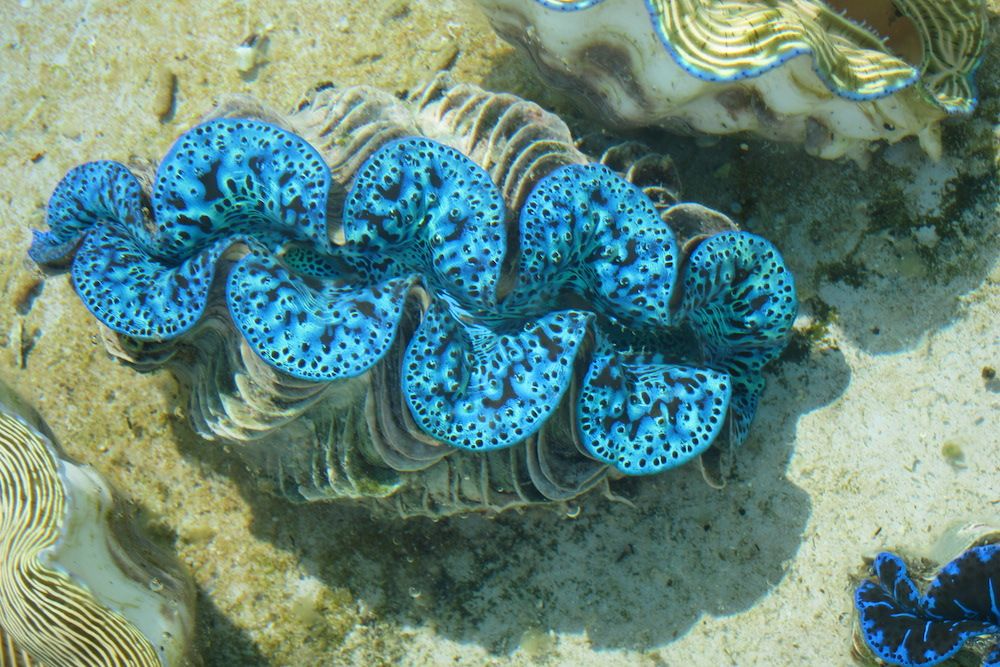Giant clam, belonging to the family Tridacnidae, are some of the most impressive and intriguing mollusks in the marine world. They are known for their immense size, vibrant colors, and symbiotic relationships with algae. Found primarily in the shallow waters of coral reefs in the Indo-Pacific region, these marine bivalves have captured the attention of marine biologists and ocean enthusiasts alike. This article delves into the biology, ecology, cultural significance, and conservation of giant clams.
Biology and Physical Characteristics
Giant clam is renowned for its enormous size. With some species, like Tridacna gigas, growing up to 1.2 meters (about 4 feet) in length and weighing over 200 kilograms (about 440 pounds). They possess two thick, fluted shells that are hinged together. The mantle, the fleshy part of the clam that is visible when the shells are open, often displays striking colors and patterns. This vibrant coloration is due to the presence of symbiotic algae called zooxanthellae, which live within the clam’s tissues.
The giant clam’s anatomy is specialized to support its large size and unique feeding habits. They have a siphon through which they draw in seawater, filtering out plankton and other small particles for nourishment. However, a significant portion of their nutritional needs is met through their symbiotic relationship with the zooxanthellae. These algae photosynthesize, providing the clams with organic compounds, while the clams offer the algae a safe habitat and access to sunlight.

Habitat and Distribution
Giant clams are primarily found in the warm, shallow waters of the Indo-Pacific region, including the Great Barrier Reef, the Coral Triangle, and the Red Sea. They thrive in coral reef environments, where they can embed themselves in the reef matrix or settle on sandy or rubble substrates. Their distribution is influenced by the availability of sunlight, which is crucial for the photosynthetic activities of their symbiotic algae.
The clams prefer depths ranging from the intertidal zone down to about 20 meters (66 feet), although some species can be found at greater depths. Their presence in coral reefs contributes to the structural complexity and biodiversity of these ecosystems, offering habitat and shelter to various marine organisms.
Symbiosis and Ecological Role
The symbiotic relationship between giant clams and zooxanthellae is a prime example of mutualism in the marine environment. This relationship is not only crucial for the survival of the clams but also for the health of coral reef ecosystems. The clams’ photosynthetic algae produce oxygen and organic compounds, which contribute to the nutrient cycling within the reef.
Giant clams also play a pivotal role in the reef’s structural integrity. Their large shells provide hard substrates for the attachment of corals, sponges, and other sessile organisms. Additionally, the clams’ feeding activities help to keep the water clear by filtering out plankton and particulate matter, promoting coral growth and resilience.
Cultural Significance
Giant clams hold a special place in the cultures and traditions of many Pacific Island communities. They are often considered symbols of longevity and prosperity. In some cultures, their shells are used in ceremonial practices or as containers for holy water. The meat of giant clams is also a delicacy in many coastal regions, valued for its flavor and texture.
Historically, the shells of giant clams have been used for various purposes, including as tools, ornaments, and even building materials. The allure of their large, beautiful shells has also made them sought-after items in the ornamental shell trade.
Threats and Conservation
Despite their ecological and cultural importance, giant clams face numerous threats. Overharvesting for their meat and shells has led to significant population declines in many areas. Destructive fishing practices, such as blast fishing and cyanide fishing, further exacerbate the problem by damaging their coral reef habitats.
Climate change poses an additional threat to giant clams. Rising sea temperatures can lead to coral bleaching, which disrupts the delicate balance of the reef ecosystem. Ocean acidification, another consequence of increased atmospheric CO2 levels, can weaken the shells of giant clams and other marine calcifiers.
Conservation efforts for giant clams are underway in various parts of the world. These include establishing marine protected areas (MPAs) to safeguard critical habitats, implementing sustainable fishing practices, and engaging in captive breeding and restocking programs. Public awareness campaigns also play a vital role in educating local communities and the global public about the importance of preserving these magnificent creatures.
Captive Breeding and Restocking
One of the most promising conservation strategies for giant clams is captive breeding and restocking. Several research institutions and marine conservation organizations have developed successful breeding programs to raise giant clams in controlled environments. The juveniles are then reintroduced into their natural habitats to bolster wild populations.
Captive breeding involves the collection of adult clams from the wild, which are then spawned in laboratory settings. The larvae are carefully nurtured through their early developmental stages until they are large enough to be released into the wild. This approach not only helps to replenish depleted populations but also reduces the pressure on wild stocks by providing an alternative source of clams for the ornamental shell trade and the seafood market.
Conclusion
Giant clam is more than just marine curiosities. They are vital components of coral reef ecosystems and hold deep cultural significance for many coastal communities. Their immense size and vibrant colors are a testament to the wonders of marine life. However, their ecological roles underscore the intricate interdependencies within reef habitats.
The threats facing giant clam are significant, but through concerted conservation efforts, there is hope for their future. Protecting these magnificent mollusks requires a combination of habitat preservation, sustainable practices, and public education. By working together, we can ensure that giant clams continue to thrive in the world’s oceans. They are contributing to the health and beauty of coral reefs for generations to come.









